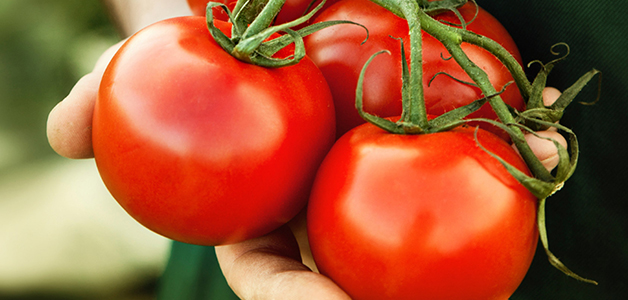Tomatoes are a popular vegetable crop, which is grown on almost every site. Excellent taste gives the dish a unique flavor, whether it is fresh tomato or canned in its own juice. However, the true value lies in the composition, rich in minerals and trace elements useful for the body. Let's talk in this article about the benefits and harms of this homemade vegetable, analyze the structure of its roots and learn how to store vegetables in the apartment.
Table of contents
The structure of the roots and root system of tomatoes
Tomato belongs to the family of solanaceous crops. The root system of the plant is well-branched, in the process of development of the shoot is formed by active growth of the lateral processes. Planting roots in the ground is better to a depth of 30-50 cm.
At the stage of seed germination, a root (germinal) is formed in the soil, which subsequently becomes the main root of the tomato. Already in the second week it is overgrown with branches. A little later, adventitious branches of the root system grow. They are formed directly from the stem, in some plants directly from the leaves.
The most extreme parts of the root system are thin hairs (fluff). It is through them that the culture receives moisture and nutrients from the soil. No wonder these areas are called the suction zone.
Gardeners when extracting a bush from a bed probably noted that the parameters and structure of the roots can be different. This is due to the fact that the plant belongs to a certain type. There are only two of them: bovine and pivotal. The moppy root has no pronounced main rhizome, it looks like a sponge (from which the name came). In contrast, the core type is characterized by a well-developed elongated root, which is significantly different in parameters from other branches. Its length is greater than the previous species.
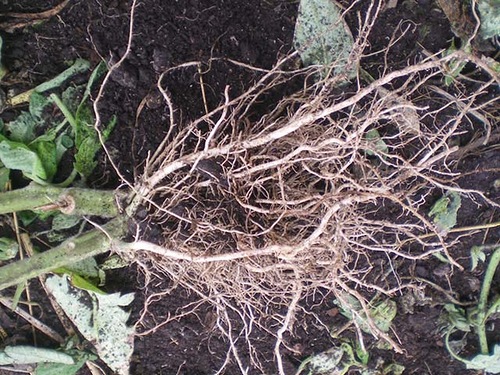
Chemical composition
The composition of tomatoes includes many micro and macro elements beneficial for the body, vitamins. Among the main ones:
- potassium;
- magnesium;
- calcium;
- iodine;
- iron;
- zinc;
- thiamine;
- riboflavin;
- beta carotene;
- vitamins PP, A, C, etc.
Fruits contain a large amount of dietary fiber, organic acids, which improve the functioning of the gastrointestinal tract. The flavonoid quercetin cleans and strengthens the blood vessels, which has a beneficial effect on the functioning of the vascular system. The composition of the tomato is a unique substance - lycopene, which reduces the risk of cancer.
Tomatoes are included in the diet due to low calorie content (per 100 gr. 21 Kcal).Fat in it is small, and the available carbohydrates are easily absorbed by the body. Low sugar content allows the use of vegetables for diabetic patients.

The benefits and harms from the use for the body of women and men
Nutritionists and doctors confirm the positive effect of tomatoes on the human body. First of all, the fruits improve the blood structure, which favorably affects the work of individual organs and all vital systems. Thinning effect prevents the formation of blood clots. And the organic acids in the composition improve digestion, which facilitates the process of assimilation of heavy foods (for example, meat).
Given the composition rich in valuable substances, we can state the following utility of tomatoes for the human body:
- the product has anti-sclerotic and anti-rheumatic effects;
- due to potassium, iron and magnesium, the work of the heart muscle is improved;
- alpha-tomin is a natural oncoprotector, which is reflected in the ability to destroy cancer cells;
- iron prevents the development of anemia, helps to restore the structure of blood after an illness.
If we consider the usefulness of the product specifically for men, the following advantages of its use are highlighted:
- prevention of prostate cancer, impotence;
- reduction of the inflammatory process in prostatitis;
- liver cleansing in the treatment of alcohol dependence.
No less valuable benefits bring tomatoes for women. Folic acid is an important component in the functioning of the female organs. Its main feature is the regulation of childbearing. Therefore, tomatoes must be included in the menu for those who want to become a mother, as well as during pregnancy. On the basis of a red vegetable in cosmetology there are many tools, the action of which is aimed at rejuvenating the skin, nourishing it with useful trace elements. It is worth emphasizing the low calorie content of the product, which allows you to include fruits in the diet. To save the beautiful shape of the figure is important.
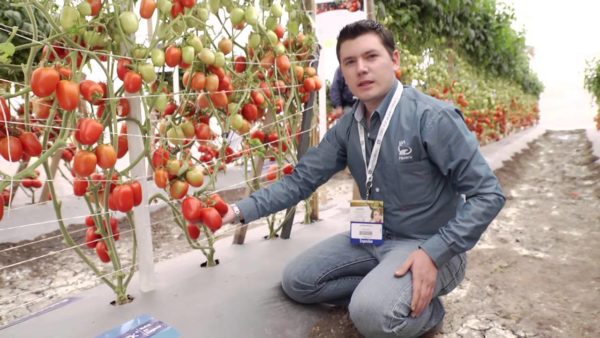
For children, tomatoes are also of great value, which is due to the rich chemical composition. Valuable micro and macronutrients are actively involved in the intensive growth of the child. The main advantages of consuming tomatoes are:
- strengthening the immune system;
- enrichment of blood with nutrients;
- detoxification of the liver;
- improvement of metabolism in the body;
- prevents the development of anemia.
Contraindications for eating tomatoes
The composition of tomatoes in addition to nutrients include organic acids, which can exacerbate chronic diseases. Therefore, it is the main contraindication for their use.
So, for example, oxalic acid adversely affects the water-salt metabolism, which causes a violation of the kidneys. It activates the digestive system, resulting in increased production of bile. In the presence of cholelithiasis, this effect provokes a deterioration of health.
You can not eat tomatoes in the presence of:
- disorders of the musculoskeletal system (acids cause severe pain in the joints);
- problems with the digestive tract;
- hypertension (to limit the use of fruits in salted and pickled form);
- pancreatitis.
Heavy smokers should not get involved in the use of fresh fruit, as tomatoes increase nicotine addiction. Of course, it is preferable to give up cigarettes in favor of tomatoes, but everyone should make this choice on their own.
To exclude tomato products from the diet should also be allergic. Tomato is a strong allergen, moreover, purchased fruits can accumulate toxic substances, which are part of various preparations for the treatment of plants.
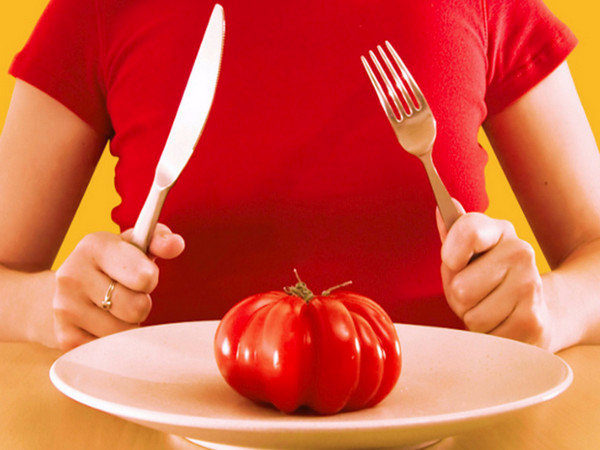
How to store tomatoes at home in the apartment?
Ripe tomato acquires an unusual flavor notes due to a combination of sugars and acids with volatile substances. It is the volatile components that are extremely susceptible to low temperatures. This explains the fact of loss of vegetable flavor after storage in the refrigerator.
But where, then, are the vegetables to be kept and what is the temperature regime for them to choose? The issue of storage of fruits of tomatoes withoutloss of taste for a long time decided by French scientists, until they confirmed by experience that the refrigerator is not a panacea. The temperature of + 20 ° C not only ensures the safety of volatile substances, but also contributes to their intensive development. However, this mode is not suitable for long-term harvest savings.
There are a few simple rules, the observance of which will make it possible to enjoy the taste of fresh tomatoes until the winter itself, or even more.
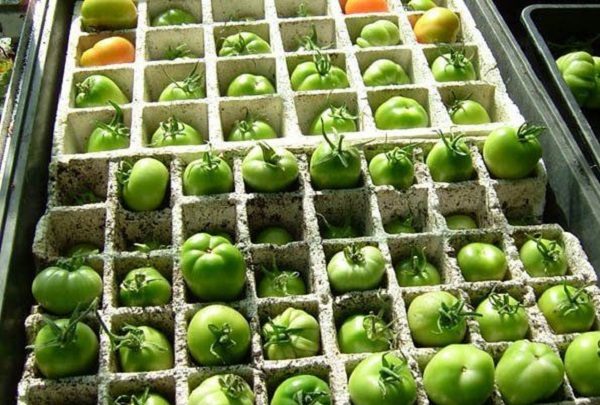
- The main clue to the issue lies in the correct selection of varieties. These should be late and medium late cultures. Of the methods of cultivation, preference is given to the open ground. Greenhouse tomatoes do not have a long shelf life. Among the recommended varieties: New Year's Eve, Red Stone (the vegetable remains dense and tasty until winter), Long Keeper, Giraffe (stays fresh until spring!). A little less (6-8 weeks) stored: Pharaoh, Viscount, Paladin. Not suitable for long-term storage of plants with early and mid-term maturation.
- Storage may be any cool dark rooms (cellars, cellars, storerooms, vegetable compartment of the refrigerator).
- The fruits retain their freshness and valuable qualities at a temperature of 8-10 ° C, air humidity - within 80%.
- An important point in storage is the proper preparation of tomatoes. They need to be sorted, removing damaged, deformed, overripe and green instances. Milk maturity vegetables are ideal for long-term preservation. To clean the tomatoes from harmful microbes, it is recommended to wipe each one with a cotton pad dipped in alcohol (vodka).
- You can fold the fruit in wooden or plastic boxes, in which there must be openings for air access. The bottom and walls of the container are covered with paper, after which the tomatoes are alternately laid out with the stalks upwards. Each layer needs to be covered with paper. In total in a box form 3 layers. The top is filled with sawdust. It is also possible to wrap each vegetable with black paper when laying. This will prevent the spread of rot in the event of damage to one of the tomatoes. With this method, the safety of the crop is guaranteed for the New Year holidays. If varieties with a long shelf life are used, you can enjoy a delicious tomato until spring. In the refrigerator, the fruit can spend no more than 7-8 days.
The usefulness of tomatoes is obvious, but it is worth eating only high-quality fruits with no signs of deformation and disease. For this, it is necessary to ensure proper storage conditions for the crop.
